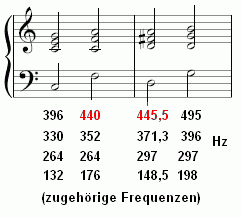Syntonic comma
The syntonic comma , also didymic comma (after Didymos the musician ), is a small musical interval in music theory , which corresponds to a frequency ratio of 81:80 (approx. 21.51 cents ). The interval plays a role in connection with mood systems and can be obtained by stringing together pure intervals .
Size and frequency ratio
The syntonic comma is the difference between the Pythagorean third (frequency ratio 81 / 64 ) and the pure third ( 5 / 4 ). A Pythagorean third case corresponds to a ditone two Pythagorean whole tones ( 9 / 8 ):
- syntonic comma = Pythagorean third - pure third = 2 Pythagorean whole tones - pure third 21.51 cents .
Since the frequency ratios are multiplied or divided when adding or subtracting intervals, the frequency ratio of the syntonic comma is calculated as follows:
The syntonic comma also occurs as the difference between a large whole tone ( 9 / 8 ) and a small whole tone ( 10 / 9 to):
- syntonic comma = large whole tone - small whole tone
Its frequency ratio is calculated as follows:
Another design option is the difference of perfect fifths 4 ( 3 / 2 ) to a pure third ( 5 / 4 ) and 2 octaves ( 2 / 1 ):
- syntonic comma = 4 perfect fifths - 2 octaves - pure major third
This relationship is the basis of the quarter-point meantone , wherein the fifths to 1 / 4 of the syntonic commas are reduced, with the aim that of 4-tempered fifths each a pure third results.
example
The syntonic comma occurs with modulations when the intonation is pure . For example, when modulating from C major to G major, not only f in f sharp ( change of sign ), but also a with the frequency 440 Hz increases by a syntonic comma in an a with 445.5 Hz (frequency ratio 445.5 ⁄ 440 = 81 ⁄ 80 ).
Modulation from C major to G major

|
Soprano only |
Because this change cannot be made with keyboard instruments , they are medium-tone , well-tempered or - nowadays almost consistently - tuned equally (see Pythagorean comma ).
Web links
- Joachim Mohr: The Pythagorean and syntonic comma




